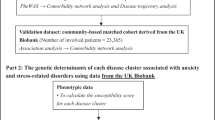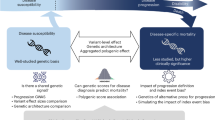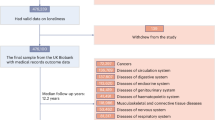Abstract
Depression is strongly associated with a range of subsequent diseases. To elucidate key mechanistic pathways for targeted interventions, this study aimed to determine the main disease networks associated with depression as well as their underlying genetic determinants. We developed a novel three-dimensional network approach which refines disease association verification by incorporating regularized partial correlations, and facilitates robust identification and visualization of disease clusters (i.e., groups of depression-associated diseases with high within-group connectivity) through both non-temporal (illustrating by x-axis and y-axis) and temporal (by z-axis) dimensions. We applied this approach to a matched cohort of 54,284 middle aged patients diagnosed with depression and their 496,005 age- and sex-matched unexposed individuals from the Swedish national registers and validated our findings in a cohort from the UK Biobank. Additionally, we conducted genetic analyses, including polygenic risk score (PRS) and genome-wide association studies (GWAS), using genetic data from 10,754 depression patients in the UK Biobank. Our analysis of the Swedish cohort identified nine reliable disease clusters consisting of 85 component diseases associated with depression, of which six clusters with 30 diseases were successfully validated using the UK Biobank cohort. These were clusters characterized by central nervous system (CNS) diseases, respiratory system diseases, cardiovascular and metabolic diseases, gastrointestinal diseases, musculoskeletal diseases, and mental disorders. PRS analysis revealed a dose-response relationship between genetic liability to depression and the susceptibility for subsequent disease clusters, while GWAS identified eight genome-wide significant loci in four of the clusters. Overall, our novel three-dimensional disease network approach identified six robust disease clusters after depression across two large cohorts, each with shared and cluster-specific genetic underpinnings. These findings warrant further research on genetic-based risk prediction and the development of therapeutic interventions aimed at health improvement for patients with depression.
This is a preview of subscription content, access via your institution
Access options
Subscribe to this journal
Receive 12 print issues and online access
$259.00 per year
only $21.58 per issue
Buy this article
- Purchase on SpringerLink
- Instant access to full article PDF
Prices may be subject to local taxes which are calculated during checkout




Similar content being viewed by others
Data availability
Researchers can request the original data for phenotypical analyses from the Swedish National Board of Health and Welfare and Statistics Sweden. Data from the UK Biobank (http://www.ukbiobank.ac.uk/) are available to all researchers upon making an application. GWAS summary data generated in the current study can be downloaded from Zenodo (https://zenodo.org/records/15380732).
Code availability
The Python code for conducting the 3D network analysis and visualizing the network is available on GitHub page (https://github.com/HZcohort/3D-Disease-Network).
References
Thaipisuttikul P, Ittasakul P, Waleeprakhon P, Wisajun P, Jullagate S. Psychiatric comorbidities in patients with major depressive disorder. Neuropsychiatr Dis Treat. 2014;10:2097–103.
Wang X, Liu Z, Li Y, Li G, Huang Y. Association of comorbidity of mood and anxiety disorders with suicidal behaviors. J Affect Disord. 2018;227:810–6.
Momen NC, Plana-Ripoll O, Agerbo E, Benros ME, Borglum AD, Christensen MK, et al. Association between mental disorders and subsequent medical conditions. N Engl J Med. 2020;382:1721–31.
Mezuk B, Eaton WW, Albrecht S, Golden SH. Depression and type 2 diabetes over the lifespan: a meta-analysis. Diabetes Care. 2008;31:2383–90.
Kessing LV. Depression and the risk for dementia. Curr Opin Psychiatry. 2012;25:457–61.
Sibelli A, Chalder T, Everitt H, Workman P, Windgassen S, Moss-Morris R. A systematic review with meta-analysis of the role of anxiety and depression in irritable bowel syndrome onset. Psychol Med. 2016;46:3065–80.
He M, Wang Q, Yao D, Li J, Bai G. Association between psychosocial disorders and gastroesophageal reflux disease: a systematic review and meta-analysis. J Neurogastroenterol Motil. 2022;28:212–21.
Jorgensen IF, Haue AD, Placido D, Hjaltelin JX, Brunak S. Disease trajectories from healthcare data: methodologies, key results, and future perspectives. Annu Rev Biomed Data Sci. 2024;7:251–76.
Dervic E, Sorger J, Yang L, Leutner M, Kautzky A, Thurner S, et al. Unraveling cradle-to-grave disease trajectories from multilayer comorbidity networks. NPJ Digit Med. 2024;7:56.
Siggaard T, Reguant R, Jorgensen IF, Haue AD, Lademann M, Aguayo-Orozco A, et al. Disease trajectory browser for exploring temporal, population-wide disease progression patterns in 7.2 million Danish patients. Nat Commun. 2020;11:4952.
Han X, Hou C, Yang H, Chen W, Ying Z, Hu Y, et al. Disease trajectories and mortality among individuals diagnosed with depression: a community-based cohort study in UK Biobank. Mol Psychiatry. 2021;26:6736–46.
Jorgensen IF, Brunak S. Time-ordered comorbidity correlations identify patients at risk of mis- and overdiagnosis. NPJ Digit Med. 2021;4:12.
Hou C, Zeng Y, Chen W, Han X, Yang H, Ying Z, et al. Medical conditions associated with coffee consumption: disease-trajectory and comorbidity network analyses of a prospective cohort study in UK Biobank. Am J Clin Nutr. 2022;116:730–40.
Sharma A, Menche J, Huang CC, Ort T, Zhou X, Kitsak M, et al. A disease module in the interactome explains disease heterogeneity, drug response and captures novel pathways and genes in asthma. Hum Mol Genet. 2015;24:3005–20.
Sun K, Goncalves JP, Larminie C, Przulj N. Predicting disease associations via biological network analysis. BMC Bioinformatics. 2014;15:304.
Halu A, De Domenico M, Arenas A, Sharma A. The multiplex network of human diseases. NPJ Syst Biol Appl. 2019;5:15.
Han X, Shen Q, Hou C, Yang H, Chen W, Zeng Y, et al. Disease clusters subsequent to anxiety and stress-related disorders and their genetic determinants. Nat Commun. 2024;15:1209.
Bycroft C, Freeman C, Petkova D, Band G, Elliott LT, Sharp K, et al. The UK Biobank resource with deep phenotyping and genomic data. Nature. 2018;562:203–9.
Burns EM, Rigby E, Mamidanna R, Bottle A, Aylin P, Ziprin P, et al. Systematic review of discharge coding accuracy. J Public Health. 2012;34:138–48.
Ludvigsson JF, Andersson E, Ekbom A, Feychting M, Kim JL, Reuterwall C, et al. External review and validation of the Swedish national inpatient register. BMC Public Health. 2011;11:450.
Everhov AH, Frisell T, Osooli M, Brooke HL, Carlsen HK, Modig K, et al. Diagnostic accuracy in the Swedish national patient register: a review including diagnoses in the outpatient register. Eur J Epidemiol. 2025;40:359–69.
Epskamp S, Fried EI. A tutorial on regularized partial correlation networks. Psychol Methods. 2018;23:617–34.
Que X, Checconi F, Petrini F, Gunnels JA. Scalable community detection with the louvain algorithm. In: Proceedings of the 2015 IEEE international parallel and distributed processing symposium. IEEE; 2015.
Clauset A, Newman ME, Moore C. Finding community structure in very large networks. Phys Rev E Stat Nonlin Soft Matter Phys. 2004;70:066111.
Major Depressive Disorder Working Group of the Psychiatric Genomics Consortium. Electronic address ameau, Major Depressive Disorder Working Group of the Psychiatric Genomics C. Trans-ancestry genome-wide study of depression identifies 697 associations implicating cell types and pharmacotherapies. Cell. 2025;188:640–52.e649.
Zheng Z, Liu S, Sidorenko J, Wang Y, Lin T, Yengo L, et al. Leveraging functional genomic annotations and genome coverage to improve polygenic prediction of complex traits within and between ancestries. Nat Genet. 2024;56:767–77.
Chang CC, Chow CC, Tellier LC, Vattikuti S, Purcell SM, Lee JJ. Second-generation PLINK: rising to the challenge of larger and richer datasets. Gigascience. 2015;4:7.
Yang J, Lee SH, Goddard ME, Visscher PM. GCTA: a tool for genome-wide complex trait analysis. Am J Hum Genet. 2011;88:76–82.
Buniello A, MacArthur JAL, Cerezo M, Harris LW, Hayhurst J, Malangone C, et al. The NHGRI-EBI GWAS catalog of published genome-wide association studies, targeted arrays and summary statistics 2019. Nucleic Acids Res. 2019;47:D1005–D1012.
Pinero J, Ramirez-Anguita JM, Sauch-Pitarch J, Ronzano F, Centeno E, Sanz F, et al. The DisGeNET knowledge platform for disease genomics: 2019 update. Nucleic Acids Res. 2020;48:D845–D855.
Sun Z, Yin H, Chen H, Chen T, Cui L, Yang F. Disease prediction via graph neural networks. IEEE J Biomed Health Inform. 2021;25:818–26.
Pearl J. An introduction to causal inference. Int J Biostat 2010; 6. https://doi.org/10.2202/1557-4679.1203.
Hamer M, Batty GD, Seldenrijk A, Kivimaki M. Antidepressant medication use and future risk of cardiovascular disease: the Scottish Health Survey. Eur Heart J. 2011;32:437–42.
Penninx BW. Depression and cardiovascular disease: epidemiological evidence on their linking mechanisms. Neurosci Biobehav Rev. 2017;74:277–86.
Kiecolt-Glaser JK, Derry HM, Fagundes CP. Inflammation: depression fans the flames and feasts on the heat. Am J Psychiatry. 2015;172:1075–91.
Lara E, Koyanagi A, Domenech-Abella J, Miret M, Ayuso-Mateos JL, Haro JM. The impact of depression on the development of mild cognitive impairment over 3 years of follow-up: a population-based study. Dement Geriatr Cogn Disord. 2017;43:155–69.
Diniz BS, Butters MA, Albert SM, Dew MA, Reynolds CF 3rd. Late-life depression and risk of vascular dementia and Alzheimer’s disease: systematic review and meta-analysis of community-based cohort studies. Br J Psychiatry. 2013;202:329–35.
Harerimana NV, Liu Y, Gerasimov ES, Duong D, Beach TG, Reiman EM, et al. Genetic evidence supporting a causal role of depression in Alzheimer’s disease. Biol Psychiatry. 2022;92:25–33.
Pan A, Sun Q, Okereke OI, Rexrode KM, Hu FB. Depression and risk of stroke morbidity and mortality: a meta-analysis and systematic review. JAMA. 2011;306:1241–9.
Lu Y, Wang Z, Georgakis MK, Lin H, Zheng L. Genetic liability to depression and risk of coronary artery disease, myocardial infarction, and other cardiovascular outcomes. J Am Heart Assoc. 2021;10:e017986.
Troubat R, Barone P, Leman S, Desmidt T, Cressant A, Atanasova B, et al. Neuroinflammation and depression: a review. Eur J Neurosci. 2021;53:151–71.
Nikkheslat N, Pariante CM, Zunszain PA. Neuroendocrine abnormalities in major depression: an insight into glucocorticoids, cytokines, and the kynurenine pathway. In: Inflammation and immunity in depression. Elsevier; 2018. pp. 45-60.
Karege F, Perret G, Bondolfi G, Schwald M, Bertschy G, Aubry JM. Decreased serum brain-derived neurotrophic factor levels in major depressed patients. Psychiatry Res. 2002;109:143–8.
Chen YW, Lin PY, Tu KY, Cheng YS, Wu CK, Tseng PT. Significantly lower nerve growth factor levels in patients with major depressive disorder than in healthy subjects: a meta-analysis and systematic review. Neuropsychiatr Dis Treat. 2015;11:925–33.
Avan A, Hachinski V. Stroke and dementia, leading causes of neurological disability and death, potential for prevention. Alzheimers Dement. 2021;17:1072–6.
Kim SY, Min C, Oh DJ, Choi HG. Reciprocal association between depression and peptic ulcers: Two longitudinal follow-up studies using a national sample cohort. Sci Rep. 2020;10:1749.
Kim SY, Kim HJ, Lim H, Kong IG, Kim M, Choi HG. Bidirectional association between gastroesophageal reflux disease and depression: two different nested case-control studies using a national sample cohort. Sci Rep. 2018;8:11748.
Li J, Zhang J, Kong B, Chen L, Yuan J, He M, et al. Abdominal obesity mediates the causal relationship between depression and the risk of gallstone disease: retrospective cohort study and Mendelian randomization analyses. J Psychosom Res. 2023;174:111474.
Zhang Y, Ma N, Duan F, Yin J, He G, Wang K et al. Depression and the occurrence of gastric cancer: a meta-analysis based on their relationship and epidemiological evaluation. J Public Health (Berl.) 2022;30:1533–43.
Ruan X, Chen J, Sun Y, Zhang Y, Zhao J, Wang X, et al. Depression and 24 gastrointestinal diseases: a Mendelian randomization study. Transl Psychiatry. 2023;13:146.
Chen D, Zhang Y, Huang T, Jia J. Depression and risk of gastrointestinal disorders: a comprehensive two-sample Mendelian randomization study of European ancestry. Psychol Med. 2023;53:7309–21.
Gong W, Guo P, Li Y, Liu L, Yan R, Liu S, et al. Role of the gut-brain axis in the shared genetic etiology between gastrointestinal tract diseases and psychiatric disorders: a genome-wide pleiotropic analysis. JAMA Psychiatry. 2023;80:360–70.
Makris AP, Karianaki M, Tsamis KI, Paschou SA. The role of the gut-brain axis in depression: endocrine, neural, and immune pathways. Hormones. 2021;20:1–12.
Liu L, Wang H, Chen X, Zhang Y, Zhang H, Xie P. Gut microbiota and its metabolites in depression: from pathogenesis to treatment. EBioMedicine. 2023;90:104527.
Kessler RC, Chiu WT, Demler O, Merikangas KR, Walters EE. Prevalence, severity, and comorbidity of 12-month DSM-IV disorders in the National Comorbidity Survey Replication. Arch Gen Psychiatry. 2005;62:617–27.
Kalin NH. The critical relationship between anxiety and depression. Am J Psychiatry. 2020;177:365–7.
Faedda GL, Baldessarini RJ, Marangoni C, Bechdolf A, Berk M, Birmaher B, et al. An International society of bipolar disorders task force report: precursors and prodromes of bipolar disorder. Bipolar Disord. 2019;21:720–40.
Cross-Disorder Group of the Psychiatric Genomics Consortium. Electronic address pmhe, Cross-Disorder Group of the Psychiatric Genomics C. Genomic relationships, novel loci, and pleiotropic mechanisms across eight psychiatric disorders. Cell. 2019;179:1469–82.e1411.
Firth J, Solmi M, Wootton RE, Vancampfort D, Schuch FB, Hoare E, et al. A meta-review of “lifestyle psychiatry”: the role of exercise, smoking, diet and sleep in the prevention and treatment of mental disorders. World Psychiatry. 2020;19:360–80.
Leonard BE. Inflammation and depression: a causal or coincidental link to the pathophysiology? Acta Neuropsychiatr. 2018;30:1–16.
Keller J, Gomez R, Williams G, Lembke A, Lazzeroni L, Murphy GM Jr, et al. HPA axis in major depression: cortisol, clinical symptomatology and genetic variation predict cognition. Mol Psychiatry. 2017;22:527–36.
Bergstedt J, Pasman JA, Ma Z, Harder A, Yao S, Parker N, et al. Distinct biological signature and modifiable risk factors underlie the comorbidity between major depressive disorder and cardiovascular disease. Nat Cardiovasc Res. 2024;3:754–69.
Zhang F, Rao S, Baranova A. Shared genetic liability between major depressive disorder and osteoarthritis. Bone Joint Res. 2022;11:12–22.
Holtzman DM. In vivo effects of ApoE and clusterin on amyloid-beta metabolism and neuropathology. J Mol Neurosci. 2004;23:247–54.
Nordestgaard BG, Langsted A. Lipoprotein(a) and cardiovascular disease. Lancet. 2024;404:1255–64.
Wang L, Chen J, Zeng Y, Wei J, Jing J, Li G, et al. Functional variant in the SLC22A3-LPAL2-LPA gene cluster contributes to the severity of coronary artery disease. Arterioscler Thromb Vasc Biol. 2016;36:1989–96.
Acknowledgements
The authors thank the team members and colleagues involved in the West China Biomedical Big Data Center–UK Biobank project for their support. Part of this research was conducted using the UK Biobank research resource (application 54803). This work uses data provided by patients and collected by the NHS as part of their care and support. This research used data assets made available by National Safe Haven as part of the Data and Connectivity National Core Study, led by Health Data Research UK in partnership with the Office for National Statistics and funded by UK Research and Innovation.
Funding
This work was supported by National Natural Science Foundation of China (grant 82404391 to Dr. Hou and 82471535 to Dr. Song); 1.3.5 Project for Disciplines of Excellence, West China Hospital, Sichuan University (grant ZYYC21005 to Dr. Song); the Sichuan Science and Technology Program (grant 2024NSFSC1568 to Dr. Hou); the University Cooperation Grant from NordForsk (PreciMent grant no. 164218 to Drs. Fang and Valdimarsdottir).
Author information
Authors and Affiliations
Contributions
HS and UAV were responsible for the study’s concept and design. CH, HL, and YG did the method development. CH, YZ, and HY did the data collection and management. CH and YZ and did the data cleaning and analysis. CH, HL, YZ, WY, FF, UAV, and HS interpreted the data. CH, UAV, and HS drafted the manuscript. All the authors approved the final manuscript as submitted and agree to be accountable for all aspects of the work.
Corresponding author
Ethics declarations
Competing interests
The authors declare no competing interests.
Ethics approval and consent to participate
The UK Biobank study has received full ethical approval from the NHS National Research Ethics Service (16/NW/0274), and all the participants provided written informed consent before data collection. The Swedish cohort study was approved by the Swedish Ethical Review Authority (Dnrs 2012/1814-31/4 and 2022-05745-02). The current study was approved by the biomedical research ethics committee of West China Hospital (2020.661). All methods were performed in accordance with the relevant guidelines and regulations.
Additional information
Publisher’s note Springer Nature remains neutral with regard to jurisdictional claims in published maps and institutional affiliations.
Supplementary information
Rights and permissions
Springer Nature or its licensor (e.g. a society or other partner) holds exclusive rights to this article under a publishing agreement with the author(s) or other rightsholder(s); author self-archiving of the accepted manuscript version of this article is solely governed by the terms of such publishing agreement and applicable law.
About this article
Cite this article
Hou, C., Liu, H., Zeng, Y. et al. Disease clusters and their genetic determinants following a diagnosis of depression: analyses based on a novel three-dimensional disease network approach. Mol Psychiatry (2025). https://doi.org/10.1038/s41380-025-03120-y
Received:
Revised:
Accepted:
Published:
DOI: https://doi.org/10.1038/s41380-025-03120-y



